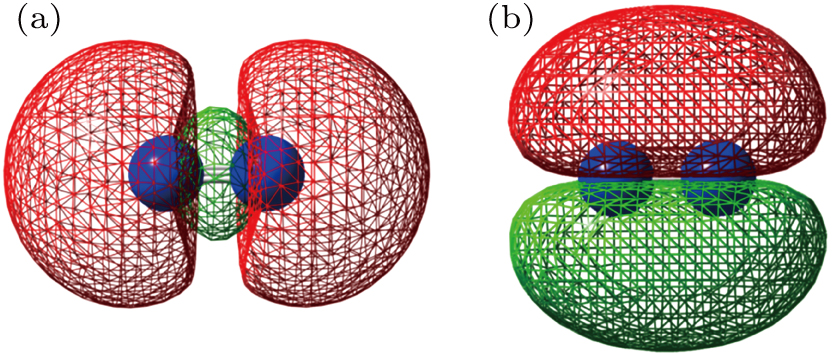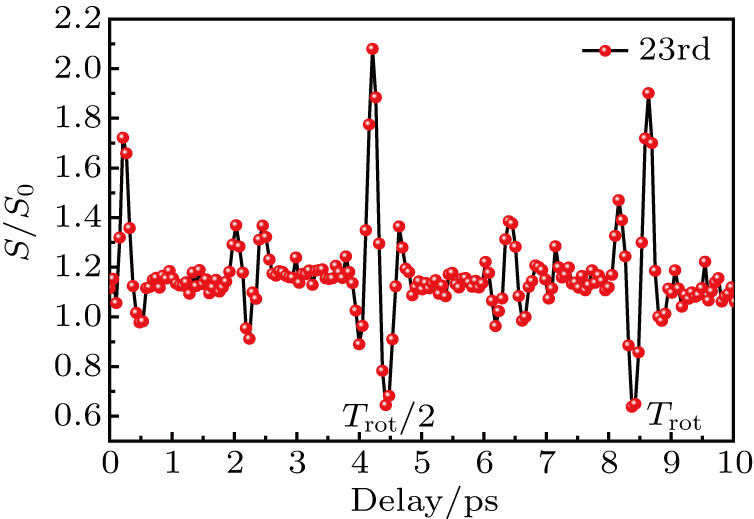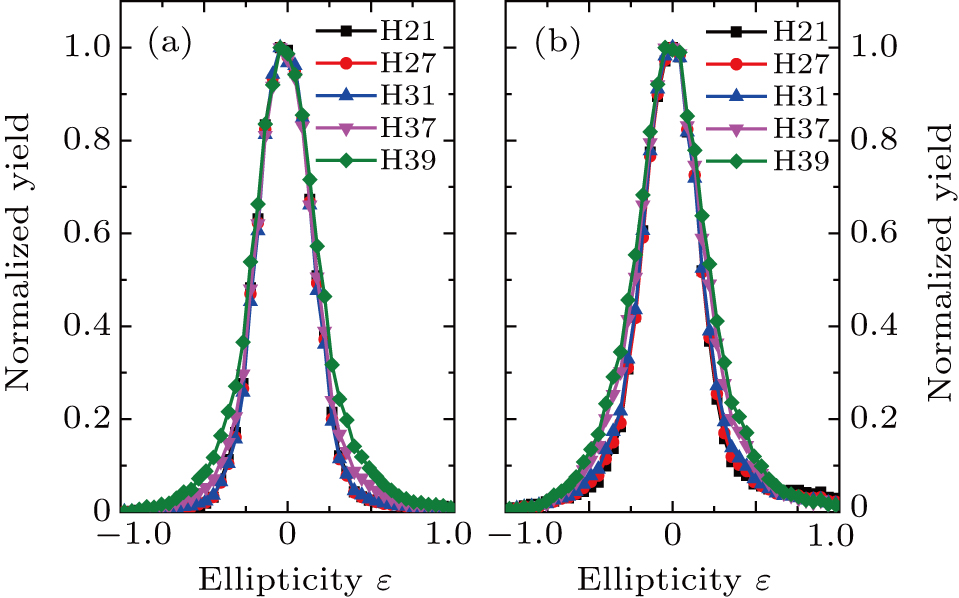† Corresponding author. E-mail:
We perform an experimental study of the multi-orbital effect on the high-order harmonic generation (HHG) from aligned N2 molecules in both linearly and elliptically polarized intense laser fields. Measured by a home-built extreme ultraviolet (XUV) flat grating spectrometer with the pump–probe method, the angular distributions of different orders of HHG are obtained, which show distinctive behaviors for harmonics in the plateau and the cut-off regions. The ellipticity dependence of HHG is investigated by aligning the molecular axis parallel or perpendicular to the laser polarization. Our results indicate that both the highest occupied molecular orbital (HOMO) as well as the lower one (HOMO-1) contribute to the HHG of N2 molecules, in either linearly or elliptically polarized intense laser field. The study paves the way for understanding the ultrafast electron dynamics of molecules exposed to an intense laser field.
High-order harmonic generation (HHG) from intense laser–matter interaction has been proven to be a fruitful method for producing extreme ultraviolet (XUV) coherent light[1–3] and attosecond pulses.[4–7] HHG is currently a key technology to obtain tabletop ultrafast short-wavelength laser sources. In the semi-classical picture, HHG can be treated as a three-step process:[8–10] First, an electron in an atom or molecule is ionized by an intense laser field through tunnel-ionization into continuum. Then, the liberated electron is driven back by the oscillating laser field, which can possibly return to the parent ionic core. Finally, the returned electron could recombine with the ionic core to emit redundant energy as coherent XUV photon flux. The emitted high-order harmonics have been shown to contain the information of the target in sub-femtosecond time scale and sub-nanometer spatial resolution. High-order harmonic spectroscopy has been used to obtain the electronic structure and dynamics of an atom or molecule in intense-field ultrafast processes, including multi-electron dynamics,[11–13] Cooper minima,[14,15] and structure interference.[16–18]
Comparing to atoms, molecules exhibit much more complex phenomena when interacting with strong laser fields due to their diverse geometric and electronic-state structures, as well as additional rotational–vibrational degrees of freedom. These features provide explicitly extra parameters to control HHG or contain more information for imaging molecular orbitals. In recent theoretical[19,20] and experimental studies,[17,21–27] the structure and symmetry of molecular orbitals have been revealed through HHG. For instance, the electronic structure of the target molecules can be revealed by observing the minimum of the molecular harmonic spectrum induced by the two-center interference.[16] By controlling the angle between the molecular axis and the driving laser field, the motion of the electron in ionization and recombination processes could be determined, providing a new opportunity to explore the geometrical structure of the molecular orbitals.
It is reasonable to expect that only the least bound molecular orbital, i.e., the highest occupied molecular orbital (HOMO), would contribute to HHG. In recent years, however, lower lying orbitals have been demonstrated to be involved in the process of HHG, showing multi-orbital effects which are encoded in the harmonic signals. For example, McFarland et al.[28] investigated HHG of aligned N2 molecules, showing the contribution of HOMO-1 by measuring the distinct revival structures between the plateau and cutoff harmonics. The contribution of HOMO-1 to HHG of N2 was further studied by Le et al.[29] using a quantitative rescattering theory. The results indicated that the contribution of HOMO-1 becomes significant near the cutoff region and depends on the intensity of the driving laser. By measuring the harmonic spectral phase of aligned N2, Diveki et al.[30] found that the relative contributions of HOMO and HOMO-1 could be manipulated by adjusting the intensity of the driving laser. Very recently, Troβ et al.[31] investigated the contribution of multiple orbitals on HHG from aligned N2 by measuring the revival structure and the angular distribution of harmonic signals.
In this work, we measure the HHG from aligned N2 molecules irradiated by a linearly or elliptically polarized strong laser field. The harmonic yield is investigated as a function of the angle 
Molecular harmonics were generated and measured by a home-built XUV flat-field grating spectrometer, which has been described in detail in our previous publications.[32–34] Briefly, the output of a Ti: sapphire laser system (1 kHz, 35 fs, 800 nm) was divided into two laser beams by a 





We present part of harmonic spectrum of nitrogen (N2) molecules irradiated by an 800 nm, 35 fs linearly polarized driving laser with peak intensity of 
 |







 | Fig. 1. (a) Part of harmonic spectrum of N2 generated by an 800 nm, 35 fs linearly polarized driving laser with peak intensity of 
|
We first measure the dependence of the harmonic intensity on the delay time between the aligning and driving lasers with linear polarization. The polarizations of the lasers are parallel to each other. Figure 

We then investigate the angular dependence of HHG by adjusting the polarization direction of the linearly polarized aligning laser with respect to that of the driving laser. Figure
 | Fig. 3. Angle-dependence of the harmonic yield for (a) H25, (b) H33, (c) H37, and (d) H39. Ratio of harmonic yield of the aligned molecules to that of the nonaligned molecules is presented. |
It is well known that molecular HHG in strong laser fields is governed by the symmetry of the molecular orbitals and the electronic structures. In other words, the harmonic yield would reflect the information of the molecular orbitals. The HOMO of N2 is a 
 | Fig. 4. Structures of (a) HOMO and (b) HOMO-1 of N2 calculated at B3LYP/6-311++G**level with Gaussian 03[39] program and plotted with Multiwfn package.[40] |
On the other hand, the peculiar angular distributions for the cutoff harmonics shown in Figs. 
In order to further explore the multi-orbital effect of HHG from aligned N2 molecules, we investigate the ellipticity dependence of HHG. Figure
One may notice from Fig. 
 | Fig. 6. Full width half maximum by fitting each curve in Fig. |
According to the simple-man model, the ellipticity dependence should be stronger for an atom with a higher ionization potential (Ip).[41] This is opposite to the present results of N2, as IP of HOMO-1 (16.96 eV) is higher than that of HOMO (15.58 eV). It is expected that the structure of different molecular orbitals should play a significant role that results in different ellipticity dependence of the harmonics. The electron in the 

In summary, we have investigated the effects of multiple orbitals to the HHG from aligned N2 molecules in both linearly and elliptically polarized strong laser fields. The measured angular dependence of HHG from aligned N2 molecules in the plateau and cutoff regions indicates the contribution from both HOMO and HOMO-1. By measuring the ellipticity dependence of different harmonic orders and different alignments, we discuss the effect of the structures of the molecular orbitals on HHG of N2 molecules. Our study indicates that the investigation on the aligned molecules with both linearly and elliptically polarized strong laser fields would open a route to investigate the multi-orbital effects on molecular HHG.
| [1] | |
| [2] | |
| [3] | |
| [4] | |
| [5] | |
| [6] | |
| [7] | |
| [8] | |
| [9] | |
| [10] | |
| [11] | |
| [12] | |
| [13] | |
| [14] | |
| [15] | |
| [16] | |
| [17] | |
| [18] | |
| [19] | |
| [20] | |
| [21] | |
| [22] | |
| [23] | |
| [24] | |
| [25] | |
| [26] | |
| [27] | |
| [28] | |
| [29] | |
| [30] | |
| [31] | |
| [32] | |
| [33] | |
| [34] | |
| [35] | |
| [36] | |
| [37] | |
| [38] | |
| [39] | |
| [40] | |
| [41] |




